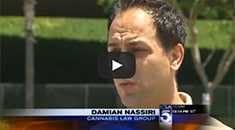Marijuana Impaired Driving Studied by Colorado Universities Using iPods
Researchers in Colorado are exploring the ways in which “dabbing” – a form of rapid consumption of cannabis concentrates by vaporizing – can impair one’s ability to drive, and they’re doing it with iPods. 
A group of researchers from the University of Colorado Boulder are teaming up with a researcher from Colorado State University to explore this highly potent method of using marijuana. CSU notes this study is a “first-of-its-kind,” and the hope is to eventually prevent instances of driving under the influence that endangers lives.
Our L.A. marijuana defense attorneys recognize that our state, like Colorado, has a vested interest in enforcing anti-impairment laws for motorists. After all, we know marijuana has the ability to impair one’s driving abilities and we know impaired drivers have slower reaction times and lowered inhibitions that can endanger passengers and other motorists. However, the problem specifically when it comes to marijuana impairment behind the wheel is that the determination is subjective.
California Vehicle Code 23152(f) holds that it is unlawful for anyone who is “under the influence” of any drug (including marijuana) to drive a vehicle. Unlike other jurisdictions, California does not set a per se limit on how much marijuana one can have in their blood before being deemed above the legal limitation. Proposition 64, which legalized marijuana even for recreational use, did not alter this statute, which can result in a maximum 6 months in county jail, among other penalties, for a first-time offense.
There are a number of marijuana DUI defenses our attorneys can help you raise, including:
- You weren’t driving the vehicle;
- You didn’t use marijuana;
- You used marijuana but were not under the influence when you drove;
- Lacking evidence that your mental and physical abilities were significantly impaired.
The exact defense raised will depend on the facts of your case.
The Colorado study looks specifically at the practice of dabbing. This is when a user inhales cannabis concentrates (70 to 90 percent comprised of THC) that are vaporized, providing an immediate rush that users describe as very strong. The study authors assert this type of research is necessary because while the practice of dabbing has expanded significantly in recent years, the research on it has been scant.
For three years with $840,000 in funding provided by the state health department, researchers are seeking existing dabbers; the team did not provide or administer the drug, as this was an observational and not a clinical study. Researchers sought to identify the effect of dabbing on motor function and reaction time. They looked at individuals’ ability to maintain balance or rapidly move their arms, fingers or legs, using information collected via an app on an iPod Touch that was affixed to the individual’s body (noting the $200 iPod device was as accurate as the $1,000 accelerometer in university labs).
Participants are being asked to complete a series of 10 tests in order to glean an accurate read of participants’ overall cognition and motor abilities.
There is little question that “dabbing and driving” is likely to be extremely dangerous, but there are still many factors that could play into whether someone is indeed “under the influence.” That would include the potency of the product consumed, the tolerance level of the user and how much time passed after use.
Previous research on the effects of THC on drivers have largely been inconclusive, and most indicate the need for additional study.
The Los Angeles CANNABIS LAW Group represents growers, dispensaries, collectives, patients and those facing marijuana charges. Call us at 949-375-4734.
Additional Resources:
An iPod in a van may uncover how dabbing cannabis can impair driving ability, Nov. 29, 2017, By Lena Ham, Colorado State University
More Blog Entries:
Tax Rate Fears Worry Some in Cannabis Industry, Nov. 22, 2017, L.A. Marijuana Lawyer Blog
 Cannabis Law Group's Medical Marijuana Legal Blog
Cannabis Law Group's Medical Marijuana Legal Blog




